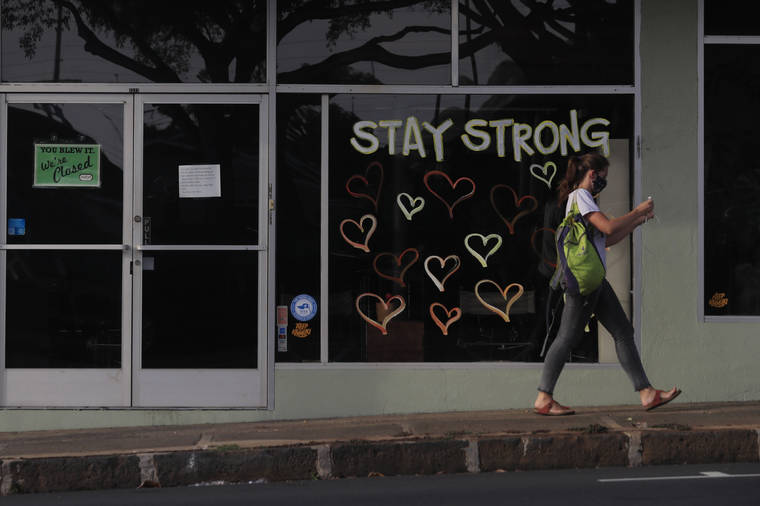Editorial: As long as COVID-19 cases tamped, strategic phased reopening in Hawaii makes sense

JAMM AQUINO / JAQUINO@STARADVERTISER.COM
A woman wearing a mask walked past a shuttered business along Waialae Avenue in Kaimuki on Friday.
The hardest step — and yet the one Hawaii is anxious to take — is the first one. It’s been a full month that the state has been in lockdown as public-health protection against a novel coronavirus Opens in a new tabpandemic Opens in a new tab. How do we get started on this never-before- traveled road toward economic and community recovery?
First, we need the resolve to get a move on it, recognizing that finding a responsible way to transition back to commerce has become imperative. This is so even though, while the transition has to be as safe as we can make it, it will remain a bumpy, learn-as-we-go process. There could be flare-ups in the outbreak forcing some open doors to close again.
But it doesn’t have to be such a confusing journey, with the mixed messaging that has come lately from government leaders. Above all, the disconnects at the state and county levels have been unsettling to the public, threatening to undermine confidence in what should be a coordinated effort toward a “new normal” way of life.
Parks and beaches: open or closed? Testing a greater swath of the population: a good thing or not? Lately, it’s depended on whom you ask. Gov. David Ige has tended to “lead from behind,” if at all, with the outcome of frustrated county mayors opting to take the plunge first.
The resulting lack of clear, statewide communication and leadership has been especially distressing on Oahu, where Honolulu Mayor Kirk Caldwell has just unveiled a plan to reopen public spaces, public and private, starting this weekend with the city parks.
He further announced that the city’s stay-at-home order would extend through May 31. That date had the effect of overwhelming his other important message: Caldwell is eyeing a phased-in reopening of businesses that present a lower risk, beginning May 1.
Don't miss out on what's happening!
Stay in touch with breaking news, as it happens, conveniently in your email inbox. It's FREE!
The mayor also wants to expand testing for the novel coronavirus, through the island’s community health centers, involving a $2 million purchase of 10,000 test kits. Ideally this would offer a good way to get a clearer picture of how far infections have penetrated into the population.
However, little about testing is ideal these days, with the development and distribution of a fast, reliable platform still a work in progress. The standoff with the state Department of Health on that issue — the mayor tabled the purchase of the test kits over state concerns about the tests’ reliability — has been the most troubling.
Encouragingly, the two sides now claim to be working toward some compromise. The department has asserted that the testing can be analyzed locally; DOH should provide needed direction and be part of the solution. But ramping up testing is the broadly accepted means of getting a handle on this disease, and state officials need to get on board with that.
As that conversation develops in the coming days, the mayor is also working to identify businesses that are most easily adaptable to social-distancing requirements and thus can open first.
Guided in part by a set of principles aimed at governors by the Johns Hopkins Bloomberg School of Public Health, the administration’s “environmental assessment” indicates that Oahu has an encouraging public-health profile, with lowered incidence of infections and stable capacity within the health-care system.
Caldwell added that the selection of businesses to open first will depend on their “risk assessment.” The list is likely to include golf courses, automated car washes, real estate agencies and car dealerships under prescribed limits, and certain smaller businesses.
Until there’s a vaccine, or at least a solid treatment therapy, the only tool in the toolkit against a COVID-19 infection is social distancing. And that prescription could mean some starting and stopping to readjust, enabling most of the long-shuttered businesses to move forward.
Oahu residents have certainly demonstrated that they do know the drill with social distancing — but they also have to know they’ll have to keep doing it for the foreseeable future. And businesses must accept that there must be significant changes in the way companies operate with the public, minimizing contact risk.
Hawaii, and all of the states, must constantly refine approaches to the pandemic, as technologies permit. Dr. Sarah Park, the state epidemiologist, told a state Senate committee on Friday that the department is working to expand the reach of its contact-tracing staff and volunteers.
That’s the process of containing an outbreak by identifying an infected person’s contacts and having them isolate themselves; building a robust contact system will be key. More sidelined state employees should be enlisted in and trained for this crucial work.
It’s critical that Hawaii stays on top of developments, that government works in coordination, that states learn from each other, and that companies and their customers reimagine ways to go about their business. The economy can recover only if everyone pulls his or her own weight.



